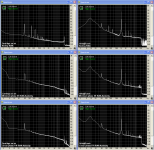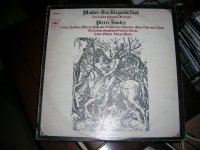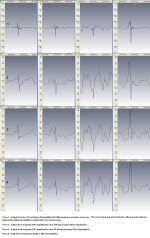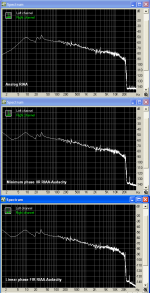It is one FFT per decade, corrected for bandwidth, from an Agilent 89441A signal
analyzer. The decades have been stitched together by gnuplot that is fed from a
C program under Linux that controls the 89441A via LAN.
Input coupling is 10u foil * 4*47Meg, probably temporarily less because the
settling time stresses my patience.
Disregard the stuff below 20 Hz, the 1/f corner is a KHz or so.
Also the total gain seems to be one dB low. (only 79, not 80 dB)
Makes sense, show it to Samuel Groner who claimed in a linear audio paper <1nV/rthz @10 Hz and 0.4nV/rthz @ some KHz, for 8 unsorted BF862's @1mA each. Good luck discussing this with him, I got the cold shoulder while politely trying to challenge his claims.
Makes sense, show it to Samuel Groner who claimed in a linear audio paper <1nV/rthz @10 Hz and 0.4nV/rthz @ some KHz, for 8 unsorted BF862's @1mA each. Good luck discussing this with him, I got the cold shoulder while politely trying to challenge his claims.
When the "discovery" of the BF862 was made I posted a picture of the Quantec's face to make a point, the 10Hz was 2.5nV @ 5mA. The noise corners do vary but once it's below 200Hz or so I don't think there is a perceptual problem. From the above I get 1.32nV at 1mA and 8 parallel, Samuel is one of the good guys and is usually careful I'm sure there is an explaination.
Last edited:
Makes sense, show it to Samuel Groner who claimed in a linear audio paper <1nV/rthz @10 Hz and 0.4nV/rthz @ some KHz, for 8 unsorted BF862's @1mA each. Good luck discussing this with him, I got the cold shoulder while politely trying to challenge his claims.
It works exactly as supposed, I checked many times. And JFETs should be matched (20%), Samuel mentioned this.
From post #89540 :
Hi George,
Not many comments.
I listened a few times to the first minute of each file.
Analog RIAA had my preference. With it, I had the feeling that the music signal is more detached from the background noise than with the two other files.
(*) Here are three files with a vinyl rip
Equipment as in post# 89507
The analog file is a recording at the Bugle output.
The IIR and FIR files are from a recording at the head preamplifier output, amplified and equalized using Audacity.
If you enjoy the content, tell me if you hear any difference.
Analog RIAA eq:
https://www.dropbox.com/s/hycjtlhro4k6o7v/analog%20RIAA%20preamplifier.wav?dl=0
FIR linear phase RIAA eq:
https://www.dropbox.com/s/patjx5d7ei88hpm/FIR linear phase RIAA.wav?dl=0
IIR minimum phase RIAA eq:
https://www.dropbox.com/s/14senz3tb3xfc2o/IIR minimum phase RIAA.wav?dl=0
Hi George,
Not many comments.
I listened a few times to the first minute of each file.
Analog RIAA had my preference. With it, I had the feeling that the music signal is more detached from the background noise than with the two other files.
FIR linear phase RIAA eq:
https://www.dropbox.com/s/patjx5d7ei88hpm/FIR linear phase RIAA.wav?dl=0
George
Is it in any way correct to use a linear phase filter here? Because pre-emphasis is minimum phase, shouldn't de-emphasis be minimum phase also in order to return to the original phase relationships?
Back on the Dynamic range issue. Currently playing a Dvorak Cello concerto from the pentatone label. Wonderfully dynamic, although the score from foobar DRM check suggests the algorithm is slightly wrong. I will need to get more from this label. The annoyance is that if you want the surround mix as well as the 2 channel as download you have to either buy it twice, or get the DSD iso (and I can't play DSD on my system at the moment).
From post #89540 :
Hi George,
Not many comments.
I listened a few times to the first minute of each file.
Analog RIAA had my preference. With it, I had the feeling that the music signal is more detached from the background noise than with the two other files.
Thank you forr for your input.
In testing, noise level is different btn analog and digital RIAA.
It seems Audacity introduces some noise when equalizes (but not when amplifies, checked). See left column in attachment 1 (cartridge on air).
When cartridge is lowered and starts reading the groove (right column in attachment 1), this difference in noise is hidden by the surface noise of the vinyl, or at least this is what the FFTs shows and what my ears discern. With these recordings I’ve uploaded (*), I can’t hear any difference btn analog, FIR or IIR RIAA.
Is it in any way correct to use a linear phase filter here? Because pre-emphasis is minimum phase, shouldn't de-emphasis be minimum phase also in order to return to the original phase relationships?
It’s one of the exercises I am running. To try myself if there is any difference btn minimum and linear phase de-emphasis.
As I said, I can’t hear a difference and I would like to have your input (my hearing acuity is not good). But minimum and linear phase RIAA de-emphasis treat cracks and pops a bit differently, see attachment 3
(*) It’s side 1 of the record you see in attachment 2, a typical case (content and condition) of the vinyl records I am interested in ripping.
George
Attachments
It works exactly as supposed, I checked many times. And JFETs should be matched (20%), Samuel mentioned this.
You checked what? And no, Samuel did not match/sort for noise. And the purpose of his matching is still unclear to me. To my experience, matching has no impact on the noise performance and jfets do not hog current.
No sorting (for 1/f noise) going on; just careful modeling of and attention to secondary noise sources which can become dominant at low frequencies if left unattended.
Some more contention points I tried to discuss and got no response, below. Perhaps I should look down and drool before asking.
- if the LF cutoff freq is 10Hz, the LF gain fluctuation (of thermal origin? Still can't find any reference about) will make noise measurements @10Hz very difficult, if possible at all.
- how were all the 50Hz harmonics eliminated from the measurement is one of those mysteries. I've tried triple shielding in air isolated iron, and the 3rd harmonic still creeps in. Unfortunately I don't live in the middle of the jungle, far away from power lines.
- theoretically, I would expect the noise to go down with the 1/4 power of the drain current; that is, a jfet @1mA would have twice the noise of the same jfet @16mA (Idss). Now of course I would not expect this to happen in practice, since there's more than the 1/4 law involved, but really, almost the same noise, to the second decimal? I got 0.32nV/rtHz for 8 unsorted BF862 @Idss and cooled down to avoid thermal effects. So did Gerhard.
- Sorted, unsorted, high current, low current, I could not get the 1/f 10Hz noise under 2.5-3nV/rtHz for 8 devices in parallel. And yes, for 1/f noise dropping at 10dB/decade with the frequency, no GR to speak of (occasional GR only makes things worse, here's a good reason to sort devices). Neither did other people building the Samuel pre (in the same thread) and neither did Gerhard for 16 devices in parallel. Don't know theoretically why, but to my experience the benefits of paralleling BF862's for the 10Hz noise performance is very small, if at all.
Last edited:
Maybe Samuel Groner was just LUCKY! Still, calling the guy a liar in his measurement just confuses everyone else. Now, I know that 8 paralleled BF862's can be about as quiet as he alleges, especially if the Idss of the parts is less than 20%, (I would prefer 10%) of each other. I would use a few more mils of current in each device just to be sure. Perhaps 3-5 ma.
Maybe Samuel Groner was just LUCKY! Still, calling the guy a liar in his measurement just confuses everyone else. Now, I know that 8 paralleled BF862's can be about as quiet as he alleges, especially if the Idss of the parts is less than 20%, (I would prefer 10%) of each other. I would use a few more mils of current in each device just to be sure. Perhaps 3-5 ma.
Who called Samuel a liar, you must be joking. Challenging data and it's interpretation thereof is as far from calling somebody a liar as you can get, in my book it's called grounds for discussion. Perhaps in your realm of reality it's different. Given your displeasure for being challenged, I would not be surprised.
To get really low noise at low frequencies you will need a transformer. The Geoformers are good to pretty low frequencies, but they roll off at upper audio frequencies- the one I'm using stops around 5 KHz, but does go to well below 5 Hz. The input noise is around .2 nV/rtHz, something not to accessible any other way. Input Z is around 50 Ohms and DCR is below 5 Ohms. There examples occasionally on eBay.
The FIR is different, isn't it?
The screenshots of clicks and pops are different.
Sweep frequency response vinyl track shows no difference 20Hz-20kHz, see attachment.
Michael, can you hear a difference btn the dropbox files?
George
Attachments
I think that was the point, you can compare the two. I have just ordered Scott's article on this to read more.
If you have any questions just ask, I still can't find a reference in the literature for that trick to make a minimum phase FIR. It works for RIAA and several other common filters I tried but might not work universally. As far as I can tell Audacity uses a conventional windowed cookbook algorithm like Parks-McClellan the windowing to reduce length gives a lot of ripple at the low end if you over do it. The differences are hard/impossible to hear on LP's since the math is buried below the noise floor.
I could also post an Excell file of the same data that I used in Foobar via foo-convolve. I don't remember the exact number ~4000 coefficients for the minimum phase FIR at 1/2 a 24 bit LSB and a essentially perfect ripple free response. What's nice is that you can just generate all the equalizations in Gary Gallo's article as minimum phase FIR's
Last edited:
To get really low noise at low frequencies you will need a transformer. The Geoformers are good to pretty low frequencies, but they roll off at upper audio frequencies- the one I'm using stops around 5 KHz, but does go to well below 5 Hz. The input noise is around .2 nV/rtHz, something not to accessible any other way. Input Z is around 50 Ohms and DCR is below 5 Ohms. There examples occasionally on eBay.
You can roll your own and get to around .06nV and down to a few Hz but it is very sensitive to source impedance.
- Status
- Not open for further replies.
- Home
- Member Areas
- The Lounge
- John Curl's Blowtorch preamplifier part II



